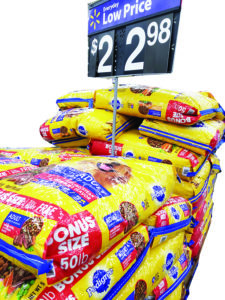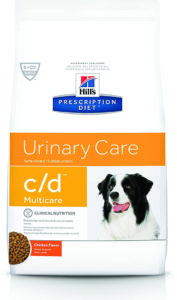
When you consider the bitter disagreements among human nutrition experts about the value of or harm from various types of diets – vegan, vegetarian, raw, ketogenic, gluten-free, paleo, organic, you name it! – it’s not surprising that there are so many myths and misconceptions about what we should feed our dogs. Not surprising, but disappointing. At least humans can choose their own diets; dogs depend on us to sort out the wheat from the chaff, so to speak. So let’s bust some myths!
MYTH 1: All “complete and balanced” dog foods that meet the nutritional levels established by the AAFCO Nutrient Profiles offer the same amount of nutrition.
TRUTH: This couldn’t be further from the truth. Not only are the amounts of macronutrients (protein, fat, fiber) in dog food wildly variable, the micronutrient levels are, too!
In this country, the legal definition of “complete and balanced” is established by a nongovernmental advisory group, the Association of American Feed Control Officials (AAFCO), which publishes the requirements for complete and balanced canine diets in tables called the “AAFCO Dog Food Nutrient Profiles.” AAFCO makes occasional adjustments to the nutrient levels in the tables as continuing studies in animal nutrition are conducted.
Unlike the “recommended daily allowance” (RDA) model that guides human diets with target nutrient levels, the AAFCO Dog Food Nutrient Profiles consist only of minimum values for all the nutrients required by dogs and maximum values for just a few nutrients that can be toxic if consumed in excessive amounts. As long as a food meets the minimum nutrient values expressed in the profiles, and doesn’t exceed the maximum values, it can be labeled as complete and balanced.
That’s why it’s possible to compare two dog foods, both labeled as complete and balanced, and discover that Food A has twice as much fat or protein as Food B, or half as much iron or zinc.
The truth is, it can take a little (or a lot) of trial and error to find foods that will fully support your dog’s health.
MYTH 2: “AAFCO Feeding Trials” are the gold standard for proving a food’s nutritional quality.
TRUTH: Actually, it’s quite possible for foods that have passed an AAFCO feeding trial to contain insufficient or excessive nutrient levels; if a food passes an AAFCO feeding trial, it doesn’t have to meet the AAFCO Nutrient Profiles criteria.
Feeding trials establish whether a food can sustain dogs for six months (at the most), which means the food may fail to maintain a dog’s health for years on end. Also, nutrient levels that depart dramatically from established minimum and/or maximum requirements for dogs can take a lot longer than six months to have deleterious effects on a dog’s health.
A true gold standard for proving the nutritional adequacy of a dog food would be something that combined both of the existing qualifiers. Doesn’t it seem like a food should have to meet the minimum and maximum nutrient levels established by AAFCO and pass a feeding trial to ensure that the food was palatable and digestible? Sigh.
MYTH 3: The best dog food is [insert the name of your favorite brand here].
TRUTH: We don’t care what brand name you insert in that myth; you’re wrong. There is no “best” food for all dogs, any more than there is a best food for all humans.
All dogs are individuals, just like all humans. While there are many of us humans who can live perfectly well on a diet of fast food and highly processed frozen and prepared foods, some of us would die on such a diet. Some people can’t eat certain ingredients – or foods that contain gluten or foods with high amounts of fat – without suffering serious consequences.
Well, it’s the same with dogs. Some can eat anything without ill effects, while others have highly sensitive digestive tracts that are in constant revolt. While we are eager to inform you about the traits of better-quality diets from reputable companies, our goal is to give you good options to choose from. You have to find what works best for your individual dogs.
Myth 4: Once you find a food that suits your dog, you shouldn’t switch.
TRUTH: You know who benefits the most from this myth? The pet food company who captured the money you spent on food when you first got your dog.
It’s true that if you feed your dog the same food for months (or years) on end and then you change that food, he will likely display some digestive upset. That doesn’t mean you shouldn’t change his food; it means you should change his food more often!
Dogs have evolved with extremely efficient and flexible digestive abilities – and for the past few thousand years, they’ve been eating our leftovers, whatever that may be. They thrive on variety, just like we do. And the more variety there is in their diet, the more robust their digestion becomes.
We strongly encourage owners to rotate among at least three different products from different pet food companies throughout the year. And more may be better! Why? Think back to Myth 1: No two foods contain the same macronutrient and micronutrient levels, and who is to say which ones have too much of this or too little of that for your dog?
Most pet food companies use the same vitamin/mineral premix for all of their dry dog foods, but the nutrient levels in the premix used by one company will undoubtedly be different than those in the premix used by other companies. If you feed only one food, or even several products from just one company, you are entrenching those nutrient levels in your dog’s body. Rotating among a few products (made by different companies) can supply nutritional balance over time.
The exception to this recommendation? Dogs who have proven to be intolerant of any change or allergic to a number of ingredients.
Myth 5: The more the food costs, the better it is.
TRUTH: The inverse of this statement is for sure true – the cheaper a food, the lower its quality – but because there are so many factors that affect pricing, the original statement is false.
Some companies spend much more money on marketing than other companies who make similar foods. Gigantic companies have an advantage in the economy of the scale of their ingredient purchasing and manufacturing costs, but may spend a ton on research and development. There are just too many factors involved to make a straight correlation between a high price and quality.

One thing you can do is to compare the price per pound of products with similar ingredients and macronutrient levels. There are relative bargains to be had among good foods. Just don’t go looking for bargain-basement foods; rest assured that they will not meet our selection criteria.
Myth 6: You should ask your veterinarian what food is best.
TRUTH: We wish with all of our hearts that this myth was true, but the harsh fact is, few veterinarians know that much about nutrition or are willing to discuss any foods except the ones they sell.
Don’t get us wrong: We respect and appreciate veterinarians, and we’re not accusing them of a profit motive here. In most cases, we suspect it’s a matter of familiarity and a limited amount of available bandwidth. As you already are aware, there are way too many products to choose from. Once a busy practitioner is convinced of the quality of particular pet food company’s products, whether because of a talented salesperson or an informative seminar she attended, she’ll tend to recommend those foods and eschew discussion of the rest.
The lure of “prescription” diets that have been developed to address medical conditions can’t be overstated. If you were a veterinarian who was already putting in 12-hour days and barely keeping up with the workload, would you rather have a 30-minute talk with a client about diets with lower magnesium, sodium, calcium, phosphorus, and fat, which are supposed to be beneficial for her dog’s urinary tract health, or just recommend a prescription diet (conveniently carried by your clinic) that has those features?
Not all vets are that interested in or knowledgeable about food. It’s always worth asking them what food they’d recommend for your dog and why. But if their only suggestion is the food sold in the clinic and there isn’t a compelling reason for that particular choice, with respect, we’d take the advice with a grain of salt.
Myth 7: Corn is poison for dogs! No, wait! It’s wheat. And soy!

Truth: If any one of these food ingredients were one-tenth as bad for dogs as people say (allergenic! indigestible!), we’d have a lot fewer dogs today. All of those ingredients have been fed to dogs for decades.
Like most myths, though, there are fine grains of partial truths behind these allegations.
Corn, and to a lesser extent, wheat, rice, and millet are prone to Aspergillus fungal infections. Aspergillus produces a highly dangerous substance called aflatoxin, which is not only a carcinogen but also can cause deadly liver damage in dogs. Pet food manufacturers that use these ingredients, especially corn, must be scrupulous about testing these ingredients as they come into their manufacturing sites and after the pet food is made.
Soy is denigrated as an ingredient in dog food for other reasons. It’s been alleged to cause allergic reactions, reduce the digestibility of protein, cause gas and diarrhea, and interfere with the absorption of minerals like calcium and iron.
When used in pet food in minor amounts – and with proper quality control and ingredient testing – none of these or many other frequently impugned ingredients should be problematic for most dogs. Half a century ago, corn and wheat, in particular, were used in such high concentrations in dog food that it was almost inevitable that dogs who lived their whole lifetimes on these foods would be inadequately nourished. (We’re approaching a similar heavy usage/overreliance on peas and other of legumes in pet food today.)
Remember: If you change brands and formulas frequently, none of them should have an opportunity to cause long-term harm.
Of course, if your dog has an adverse response to any food, stop feeding it. Give him a different food until his symptoms resolve, then try it once more. If the problem recurs, or if it causes a similar reaction in more than one of your dogs, see if you can return it. Ask your retailer to report the issue to the manufacturer, or contact the manufacturer yourself. Note the ingredients on a calendar or your dog’s health journal so you can try to identify a pattern of problems that you can link to certain ingredients or brands of food.
Nancy Kerns is the editor of WDJ.
Related Articles
Subscriber Only: Whole Dog Journal’s Approved Dry Dog Foods for 2021
Whole Dog Journal’s Free Guide on Dry Dog Food





Great article! Finally, something truthful without an agenda. Hope to see more.
Interesting article and I appreciate you explaining how corn in and of itself is not an issue but the handling in the safety of the ingredient batch etc. however I am curious to know like many articles I read a very subjects statements such as yours about veterinarians knowing nutrition. You wrote that veterinarians do not really know much about nutrition for dogs and just left it at that. I would like to know what basis that statement was made? It sounds more like an opinion than fact. You also wrote in so many words home veterinarians would rather just recommend one of their prescription foods etc. and explain and the nutritional needs for your dog or cat. I like many others have a veterinarian (along with the other 10 vets at the practice) that didn’t take the time to explain why a certain prescribed food or such will help with a UTI infection or kidney issues etc., of a dog or cat. So that’s my only beef with your article no pun intended. Lol. Ie, more so the statement you made that most of us don’t know about nutrition for dogs.
Good question. I asked my veterinarian how many required courses they had on nutrition in vet school (in this case 1). They did take a continuing ed class. I would urge people to ask their vet what their background is in nutrition.
Excellent answer!
Feed raw. Commercial dog food is garbage. Up until the mid 20th century, dogs ate human-grade food scraps. Then big name food companies saw the profit to be made from processed grains and meat by-products. Look up “extrusion,” the process by which dog food is made. My dogs eat fresh human-grade meat and bones from the grocery store, plus eggs, yogurt, fish oil and probiotics. Balanced, easy, and inexpensive compared to the cost of commercial food and vet visits for allergies, dental cleaning, skin and digestive issues. I’ve been feeding this way for more than twenty years and the health and condition of my dogs speaks for itself.
Yup! I agree completely. My dog is on raw 80/10/10`and doing great: she is ripped with muscle, she is energetic and healthy. A recent physical confirmed all this.
On a side note, I have discussed raw diets with three vets and was surprised how little they actually know about nutrition and nutrition is the foundation of good health.
Thanks for the great info!
i cook fresh food for my dogs easy no more tome consuming than cooking a casserole, both dogs perfectly healthy shiny coats good teeth nice slim and its cheap i am lucky i have a great butcher though
I am concerned that some foods on your list contain copper sulfate, which from articles i have read can be toxic. Apparently the less synthetic copper proteinate or chelated copper is better. So why are the copper sulfate brands included?
I did feed raw but now my dog is a senior and has some health issues (of course the vet prescribed prescription food for and said she had no real nutritional knowledge other than what she was taught by Hills) I cook his food (I researched how to do it correctly) and he is doing great (55lb 15yo).
I am very interested in giving my 8 yr old female chihuahua good food, and would like to know if you follow a recipe / guidelines for your cooked food? Her teeth have suffered from her previous diet and as a result (along with hereditary factors perhaps?) she has no front upper and lower teeth and only 15 overall remaining 🙁
Thank you in advance for any information.
I would love to see an article on any scientific research regarding high/low protein diets and “aggression” (for lack of a better word).
Protein from meat and eggs is best, protein from grains and legumes is not. When I started raw my dogs aggression almost disappeared, training and lack of carbs! Carbs for dogs is giving a hyper kids candy.
Remember too, that both cereals (grass seeds like wheat/corn/rye) and pulses (legume seeds like peas, beans and lentils) have what is called ‘incomplete proteins’ – neither category provides all the protein needed by ‘carnivores’. Is is better to consume these seeds in a mix so that more protein is digested and absorbed by the consumer, rather than just making a richer urine.
We have a dog with a very touchy tummy. We tried Science Diet and Fat Dog among many many others and found only 2 makers that his tummy did not rebel against. We switch flavors among the one maker because they offer food with wild game protein which our Veterinarian recommended. He’s a little overweight but healthy and active.
Because of the sensitivity issue we are very hesitant to change between maker companies.
I have had veterinarians tell me that they were required to take at least one course in nutrition in school and considered themselves well educated in canine nutrition. On what do you base your statement “few veterinarians know that much about nutrition?”
Because” at least one course” is not enough. Most only have one course, as that is all that is required in their education. Speak to a Veterinary Nutritionist. They are vets with a significant amount of additional training in nutrition. That’s who you should speak to if you have nutrition questions about dog food in this crazy marketplace. Here’s an example: Our vet was purchased by VCA and suddenly all the vets there were pushing Royal Canin. A little research on our part found that both VCA and Royal Canin are owned by the same corporation–M&M/Mars. Our puppy was having diarrhea issues and the vet kept blaming the food we were feeding her. I kept asking them to deworm her and they just said to feed her probiotics and their Royal Canin specialist diet. Guess what? It didn’t work. She’d be better then get worse again. Finally, one of the older vets saw us and immediately dewormed her. She recovered with no issues. Speaking to a veterinary nutritionist helped us confirm that the food we were feeding was FINE and that we shouldn’t trust the vet’s food recommendations. I absolutely trust my vet for surgery, immunizations, etc. Just not for her feeding.
At least at the turn of the century, the only ‘canine nutrition’ course run here for vet students was run by a Dog Food manufacturer 🙁
Lookin at the food that the Vat sticks I doubt it has got much better.
I would love to cook or feed a raw diet, but find it too confusing in order to ensure the dog receives all the necessary nutrients.
I would welcome an article just on that with recipes…
Dr Karen Becker has excellent recipe books for dog food.
I just think about my dog and I I’m so happy to have a dog .
My dog licks and bites his legs when he’s being fed a dog food with corn.I’m thinking of going grain -free to stop thi strange behavior.
*this*
Give up maize (aka CORN) it is the poorest of cereals, I feed a mix of one measure of pulse ( lentils or peas) and three measures of brown rice or whole grain rolled oats 00 all boiled with water of course, I add this to their fresh meat and add a supplement formulated for working dogs.
I also add some gelatine (since there is little in pure muscle meat) and some vegetable oil
because i feed Kangaroo meat which is very lean. Dogs are all in good health, with their daily tail bone as well 🙂
And sorry, But I would NEVER again feed commercial rations, I used to but the recipe/ingredients were changed without any notification, and the dogs suffered 🙁
I feed farmers dog ….is it good food?
I have a Chihuahua mix who our vet says is overweight. He is two and weights 23 pounds, he has no health problems and is a very active little boy. Our vet had him try Hills Science script food but he did not lose weight and he is constantly hungry as the cup measure a half cup of food twice a day and the kernels are rather large. I felt so bad that he was still hungry so I mixed Blue Buffalo Fit and Healthy with the Hills Science which being a smaller kernel gave him a tad more food. I am trying to find the BEST DIET food for him and I know the vet is only interested in selling me the expensive brands they carry. It is not that we cannot afford the expensive food, it is just that I want the best for our furry baby. I hope you can give me some advice on what toffee this precious little man of ours.
I put my pudgy doxie on Purina pro weight management and he is losing a little over a pound a month and he loves his food. I can only tell you about my experience with my dog.
My GSD and my two mutts are on the same food, recommended by my vet, and my GSD actually has a waist and hips again. Still got a bit of a pot belly, but that’s receding too. My two girls…well, one of them is a senior, with arthritis and ASL issues so she doesn’t get as much exercise as my GSD, so her weight is coming off slowly. My newest one (adopted April 2 along with her newborn puppies) was a street stray before we got her, so she was really fat– EVERYONE in our neighborhood was feeding her EVERYTHING. Her pups are all weaned, rehomed, and the weight is coming off.
We go back and forth between Purina Pro weight management (we have a hard time getting it sometimes, supply is an issue) and Blue Buffalo Healthy Weight. They seem to do well on both.
I am a Chihuahua mama, too. You may have to consider that your guy isn’t really as hungry as you think that he is. I know it is hard, because they are very cute; but they are master manipulators!! Having owned and fostered many other breeds, I can tell you that no other breed or breed mix of dog can compete with a Chihuahua when it comes to getting us to give them what they want! 🙂 You may also want to consider giving cooked or freeze dried meat as treats throughout the day. He will think he is winning because you are giving him a lot, but the treats are only meat – no other ingredients – so the calories are minimal and the pure & complete protein will make him feel full.
Good suggestions Gina, and I wholeheartedly agree (from personal experience as a Chi owner myself) they are masters at manipulating for food 🙂
I feed my three-year-old Beagle mix a combo of canned and dry food. She doesn’t like kibble only. After reading WDJ, I started buying different brands of both to switch around. She is very active and healthy, and just had her yearly vet exam. For the first time, her vet asked me what I fed her. She wasn’t concerned with which brands or flavors, just wanted to make sure she was not being fed grain-free foods. Discussing it later with my husband, we recalled the foods our parents fed our dogs when we were kids in the 60’s and 70’s. None were close to the foods many people feed their dogs today, but they were all long-lived and healthy!
My former vet had me running circles with two different prescription dog foods for my Shih Tzu’s. I finally had enough and researched for months to come up with the right recipes to home cook their food. They each are now on their own recipes for a year and their blood work and other tests have greatly improved. I also changed vets. I have one now that works with me to be sure they are not lacking in any nutrients and she also admits she likes working with me because I have done so much research she is learning, too. If you would like to get started with home cooking, check out Balance It website. You can learn a lot and they have the vitamins you need to go along with the recipes.
Awesome comment Cheryl, I will check out the Balance It site.Thank you
This article shows a blatant inadequacy in Canine Nutrition. Although Veterinarians may take limited training in canine nutrition during their studies, in the majority of Clinics, the foods they stock and thus recommend are thoroughly researched and formulated by the companies that manufacture them. That is what makes them safe for a veterinarian to prescribe.
Before the author rattles on about things like Soy, the author should have a better understanding about every ingredient. Soy especially contains plant hormones’ that can interfere with your canine’s own hormones.
My beef with pet food is that the copper ppm is not listed on the bag along with other info. Sure, you can call the manufacturer but some don’t reply so I just don’t buy their food. They would save themselves a lot of work if they just listed it!
Fabulous article. Well written and gets to explains the most basic and important aspects of dog food and what to understand when selecting food for your best friend.
I cook for my dog…I make about 20 days of food and portion it into containers which I freeze. I went over my recipe with my vet to see if it was ok. I take out 2 days at a time to defrost. The base part is chicken and every time I make a batch, I add either, fish or beef or liver and I add vegetables. Then when I finish cooking it…I add tumeric, nutritional yeast, a little garlic and a very little bit of dry dog food. I pulse it in my food processor and I taste it (before adding the dog food) and it taste really good. My dog loves it!
My dog is on Ollie – similar to Farmers Dog. Is it good?
My dogs Vet. is not familiar with ANY of the well known and great dog foods. My Callie ended up with what they “believe” was pancreatitis, after Xray, blood work, and IV’s. The Vet suggested a low fat diet. Guess what, they sell the low fat canned dog food. For Callie to get her daily calorie and nutrients she had to eat almost a whole can of this expensive PurinaPro Low Fat. I agree with this article, if minimum has to be listed so should the maximum. I have no idea, looking for a low fat, what the maximum might be.
I have tried the home cooked and found it to be very expensive. I’ll look at the Balance It web sight and may start again.
Thanks for the article. Look forward to more.
Corn, soy and wheat, regardless of how well they are cared for, aren’t good foods for dogs. They are cheap fillers for the food manufacturer. I have used many kibbles but now am feeding raw to my 9.5 year old and 3 month old GSDs.
I have 2 large dogs (3 year old male Lab and 8 year old female Lab/Golden). I rotate between good quality kibble and canned food. My female was getting fat, I switched to weight control kibble and canned for her. I also buy Tuckers raw food and both dogs love that but I can’t afford to feed that exclusively. I also supplement with Wholistic Canine Complete Joint Health and fish oil. At her last wellness visit our vet commented on how healthy my 8 year old female is.
I have four dogs. One is a senior– about 12 years old, a pit beagle mix. She has arthritis and ACL issues, so her mobility is limited. The next is a GSD, he’s about 7. My newest one is about 3 years old, and she’s a neighborhood stray we took in with her six newborn pups on April 2. Pups are weaned and rehomed, but she’s still rolypoly. Now that she’s fixed, ALL three of them are on Purina Pro Weight Control, recommended by my vet. (My fourth is a 2 year old husky who is, my vet assures me, is in perfect shape. My husband, however, is convinced my husky is too skinny. So you see what I’m up against.) My husky gets extra food so he doesn’t get underweight. He will NOT eat unless he gets the exact SAME food the others get, so he’s getting the skinny food, too.
The two are slimming down more so than my old girl, but that’s because they get 2 mile walks every day. But my old girl is slimming down, too, albeit slowly.
We have issues with supply on the Purina Pro, so I do swap out with Blue Buffalo healthy weight from time to time, so they don’t get too bored. I also make their wet food myself–greens, veggies, squash, cucumbers, tomatoes, cheese, meat, grains, corn, carrots, peas, riced cauliflower, broccoli–and mix it with two eggs every night. It varies from week to week…sometimes I mix in any leftover apples, strawberries and blackberries from our fruit cups, along with canned dog food varieties to keep them from getting bored. Add in the various vitamins, supplements for each of them… and the only bills I have for them are their yearlies. Except for my GSD. He LOVES to hurt himself, the big oaf.
The “best food” is the food I make for them.